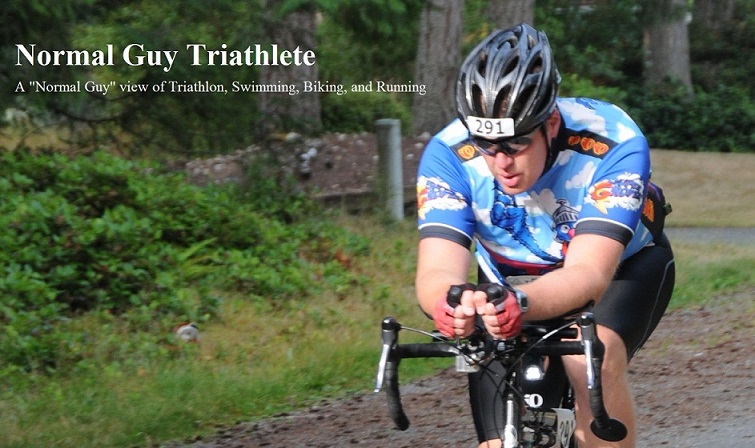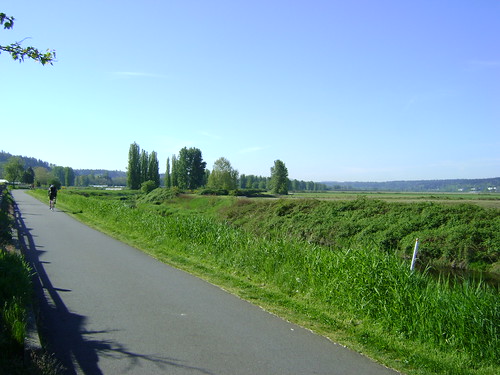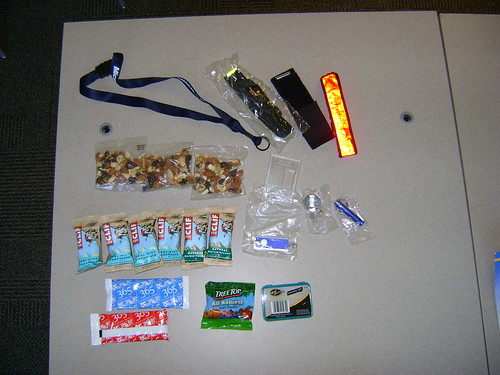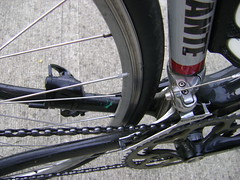This post is the third in a series on bike commuting and covers some of the "how" related to bike commuting. Other posts include How?, Why?, When?, and Weather Issues.
Update: Active.com just posted a great article titled "How To Handle a Bike Accident With a Vehicle." It's a great read outlining the steps you should take if you are involved in a bike/car accident. The same principles apply in just about any moving-vehicle accident.
From the article-
"So what do you do if you're in a cycling accident with a vehicle? If you're healthy enough to walk away from the crash site, that doesn't mean you should consider that the only victory you need. Instead, take these steps to make sure you're as protected as you can be."
~-~-~-~-~-~-~-~-~-~-~-~-~-~-~-~-~-~-~-~-~-~-~-~-~-~-~
When I tell people that I commute by bicycle to work year-round I get some pretty interesting responses. After telling me I'm crazy, the responses generally fall into three basic categories-
"It rains 9 months of the year in Seattle."
"It is really dark for 6 months out of the year."
"Wait, don't you live at the top of a big hill?"
My first response is typically a rip-off of Dr. Sheldon Cooper: "I'm not crazy, my mother had me tested." Well, she didn't actually have me tested but it does get a laugh. Am I crazy for riding in the rain? Sometimes I wonder about that myself. I bike in all weather except snow/ice.
Sunny and hot? Check.
Sunny and cold? Check.
Cold and monsoon rain? Check.
Dark when I leave in the morning and dark when I get home in the evening? Check.
Dark and raining so hard that you literally POUR water out of your shoes? Check.
When I walk in the door, dripping wet and soaked through to the skin with a smile on my face, my wife always looks at me funny.
Me: "Wow, I feel like a wet rat."
Wife: "...And my nose is cold! And my tail is cold!" (Quoting 101 Dalmatians)
It is possible to be soaking wet and still warm but I'll leave that for a future post about commuting in the rain.
General safety
Safety is my #1 concern for any outdoor activity, much to the dismay of my children. My most stressful time as a parent was standing at the top of a 750 foot cliff east of Seattle with my three boys. I have never been more afraid as a parent as I was during our 15 minutes at the top looking down at the lake below. Now I understand those "child leashes" you see at the mall. Call me a control freak but when my kids repeated ignored my request to "stay away from the edge!" it ended our little hiking trip in a hurry. This is one of the few photos I took from the top before we headed down-
Boy #3 looking out over the great expanse of the Cascades from Rattlesnake Ledge just east of Seattle.
I could write page after page after page of basic safety information but I'm sure most of you don't need to partake of that particular brand of sleep-aid. Countless other folks have addressed that issue far more eloquently and authoritatively. I can't get away from some of that but, instead of waxing profoundly obvious, I hope to contribute some of the things I do that may be unique, peculiar, or just plain odd.
Riding a bicycle on roads in the U.S. is a risky proposition no matter how you slice it. You could be riding along a country road, minding your own business, when *BAM!* you are hit from behind by a driver with a suspended license who isn't paying attention (driver in this case claimed to not even know he hit a cyclist and continued on his way to work). You can't avoid the bad choices of other nut-jobs out there but you can make it easier for them to see you and avoid getting into a bad situation.
Visibility
A friend from work, who commutes by both bicylcle and motorcycle, gave me this advice a couple of years ago: "Treat all cars as if they don't see see you. You are invisible to them."
What happens when they don't see you? You have to take evasive action...
The rider in that case was crossing in a crosswalk, with the walk signal in his favor, and still was hit. The driver wasn't paying attention and was trying to run a light. Riding between stopped cars like that is also fraught with peril but the main issue here is that the driver simply didn't see the rider in time to miss him. She did see him early enough to only tap him with her car as opposed to running straight through him which undoubtedly saved his life.
So how do you make yourself seen? After you have realized that you cannot make people see you, consider the following steps-
Bright Clothing - the fluorescent green/yellow jackets seem to be very popular these days. I have a couple of jerseys that color but my jackets are old-school yellow. "Construction orange" also works well. On cold days I look something like this-
Reflective clothing and bike stickers - Most of my fall/winter commute clothing has reflective piping, screen printing, or decals. My bike and bags have them too. I even added a few. The best reflective material for stickers is the stuff they use to make road signs. There are various sources out there on the interwebs.
"Other" lights - I have been experimenting with other forms of "non-traditional lighting" for my bike. (UPDATE: My bike light review!) Seeing a guy with his bike wrapped completely in Christmas lights inspired me. A couple of people around Seattle even have the Down-Low Glow. This subject will have to have its own after I have some time to play with the lights and actually review them.
Not completely sold on the idea of bright clothing? This video does a nice job illustrating the difference between a cyclist wearing a bright jacket and one wearing all black. Which one would you rather be while riding in traffic on a rainy night?
Riding on trails
As far as overall safety is concerned you can't beat trails. Without the threat of cars your chances of actually dying while riding are significantly reduced. While this is true about fatalities it is not necessarily true about injuries or incidents in general. Trails are filled with other types of traffic such as walkers, joggers, kids just learning to ride their bicycle, skateboarders, roller-bladers, and, my all-time favorite, cross-country skiers. Yes, I have seen skiers on the trails that I use in the Redmond area but they are typically riding on skis with wheels. If this were Butte, Montana there might be real skiers on the trail but that would require actual snow.
...or cross-country snow boarders. You can't make this stuff up, but I digress.
I have a commute route that is back roads and trails all the way home. Yes, it is about 2.5 miles further but on cold, dark, rainy days I would much rather take the long way home and meet 2-5 cars than be passed by 100+ cars with impaired visibility and stopping distance.
Some tips for trail riding-
Cover your light: When you pass oncoming traffic, be sure to cover your bright-as-the-surface-of-the-sun headlight. It's tough to see when you are riding into a bright headlight. As you get closer to an oncoming rider, cover your light with your hand. I've been known to shout at people who don't do this because if I can't see the least I can do is annoy or scare you. }B^)
Watch out for young kids on small bikes. Multi-use trails, like the Burke-Gilman Trail in Seattle or Lake Shore Drive in Chicago, have all types of traffic but young kids, although cute, are the worst. They are unsteady, slow, and, worst of all, unpredictable. Don't get me wrong, I love watching little kids learn to ride, and they should always be allowed on public trails, but I find them very difficult to ride around safely.
DO NOT wear headphones. They are very distracting and you can't hear me yell "on your left". Or the cursing of that jogger you just side-swiped.
Watch out for Dog Walkers. Gotta love them. Most dogs are curious and want to play, unless they are looking to chew off your face. Either way dogs love to come toward you or dart across the trail to clothesline you with their leashes. Give them lots of room, slow down, and keep your hands on the brakes.
Riding in traffic
If you like to ride faster than 15 MPH then roads are pretty much your only legal choice in Washington State. Some trails have speed limits at 15 MPH, some don't have any, and some are as low as 10 MPH (no, I'm not kidding).
I have heard a few cyclists say that you must assume that all cars are trying to kill you. While this does put you in a defensive mindset while riding, which is a good thing, it can make you over paranoid and that doesn't really help you ride safer. You should ALWAYS be on the look-out and ready to react.
...even when you are riding across Africa and forget to yield to cross traffic, which apparently doesn't stop.
Get a rear-view mirror. I use the 3rd Eye bicycle mirror bar end mirror. It has the perfect mix of adjusts and stability.
Stay OFF the sidewalks! The only times I have EVER come close to hitting a bicycle rider while driving my car was when they were riding on a sidewalk at a faster-than-jogging speed (i.e. more than about 8 MPH). Drivers don't expect sidewalk traffic to be going faster than that speed so they rarely look.
Ride in bike lanes or, when there is no bike lane, in the lane of traffic. Your local laws may vary, but in Washington State you are allowed to ride wherever it is safe: if the bike lane is not safe then you are allowed to take the lane (RCW 46.61.770)
MOST IMPORTANT: be predictable.
Your local and state laws may differ significantly from Washington State so make sure to do your homework.
When I am riding in traffic I go for bike lanes and wide shoulders, preferring roads with these features over those that don't. If you find yourself on a road without either I suggest taking up a lane. Yes, I mean that you should block traffic if you have to. If you ride too close to the right then cars are tempted to squeeze past in the remaining space which may not be the safest thing for you, the rider. You should always use your best judgement and obey traffic laws but that is my personal suggestion about lane placement.
Drafting and Pace Lines
Call them drafters, pace lines, wheel suckers, whatever.. I hate them. Not that I personally dislike the riders I just don't like riding that close to other riders. It rarely turns out well for me. Several times, as recently as last month, I have almost crashed in pace-lines because of the stupid actions of another rider. Being in a pace line is a privilege, not a right. If you learn the etiquette and hand signals for pace line riding it can be a life-saver on long rides. It can also be a disaster.
Moral of the story: don't use aero-bars unless you are at the FRONT of the pace line.
Many times people have come up behind me to draft and I don’t even know they are there. Now that I ride with a rear-view mirror this is not as much of a problem. One day back in '07, while riding home on a local MUT, I passed a guy going the other direction who waved vigorously and shouted, “Hi Tim!” Someone behind me shouted something like, “Hi Mark!” He was so close it almost made me jump out off my bike. I had no clue he was there. Perhaps I should be doing a routine clearing of the baffles a la “Crazy Ivan” from Red October (my wife’s suggestion)? Drafting behind someone without their knowledge seems like a very dangerous situation.
Not long after that I was riding on the Sammamish River Trail from Bothell to Redmond in Washington State. I passed through a section with some tight turns under a railroad trestle in Redmond. As I came around one of the bends I found a mother goose crossing the trail with her goslings. Canadian geese are very common in Redmond along the Sammamish River, especially in the fall and spring. Good thing I had already slowed down for the blind curves. When I saw the geese I hit my brakes hard and came to a stop when I suddenly heard, "Oh Sh*t!" behind me followed immediately by the unmistakable sound of metal hitting metal and carbon fiber several times. I immediately jumped to the side thinking I was about to get hit from behind. Scattered on the ground behind me were 4 riders all in a heap. They had been drafting me and I didn't even know it. They all ended up riding away from the scene with only scrapes and bruises leaving me shaking my head.
As they rode away I called out, "How long were you guys behind me?"
"Since Woodinville." That was 6 miles or about 20 minutes given my average speed back then. The next week I bought a mirror.
If you MUST draft...
Stay away from me. Seriously. If I wanted you to draft me I would invite you. The only drafting I allow is in times of war.
Make sure the person you are drafting knows that you are back there. Shout something like, "On your wheel!" or "Do you mind if I draft?"
Know the etiquette and hand signals for turns, slowing, road hazards, etc. The best way to do that is to ask someone because everyone seems to do it somewhat differently.
Only take the lead if you know what you are doing. If you don't have a clue how to lead a pace line admit it and ask to stay back in the pack. If you screw things up you will get some choice words from the other riders and then dropped like 3rd period French.
Hills
I live around hills. Big hills. Think "San Francisco" style hills. They simply can't be avoided. Don't believe me? My rain route has a hill section 200m long with an average grade of around 16% and a max of about 20-22%. I don't always have to take that route but the alternatives are a 1 mile hill with a 10% grade and a 1/2 mile hill with a 13% grade. A pitch like that will get your attention. Going up steep hills is one thing but going down them, especially in the rain, can be tricky.
In 2007, when I got back into cycling, I bought a cheap bike computer. One day I was going down my favorite hill, in traffic, and decided I was going fast enough to "take the lane" and ride with traffic. I knew I was going over 40 MPH but it didn't feel all that fast. When I hit the bottom I glanced down at my bike computer to find my max speed: 52.7 MPH. Holy cow. That was, and will remain, my fastest recorded land speed record. On that descent I pulled into traffic about 50 feet behind a panel truck, thinking they might be safer to follow than an SUV or mini-van. What I didn't realize was that, even at 50 feet, I was still in his air pocket. In a sense I was drafting him. That's why it didn't feel that fast. I pondered on that speed all day. That was a risk I should not have taken. I control my speed much better now.
Over at the Fat Cyclist blog, Fatty tells about his experience riding in France where one of the riders in his group crashed on a fast downhill. That little incident resulted in multiple fractures for the rider, one of them a compound fracture.
In 2010 I found myself head-over-heels after coming into a turn too fast during a triathlon. It happens to the best of us. }B^)
If you ride hills...
Check your brakes frequently - The last place you want to discover your worn out brake pads is when you are bombing a descent at 40 MPH. Your helmet is not rated for crashes at that speed and spandex... well, you get the picture.
Invest in a bike with disk brakes - My new commuter bike has disks and I LOVE IT. If you can't put disks on your existing commuter then...
Consider ceramic-coated rims for your next wheelset - They offer similar stopping power to disk at much lighter weight and can be put on just about any bike.
Keep your speed under control - The best way to minimize stopping distance is to minimize speed. Yes, I love to bomb down my favorite hill but only in good weather and during light traffic. Other times I keep my speed down and my hands on the brake hoods.
Get to know the stopping power of your brakes and how long it takes to do an emergency stop. Have you ever TRIED locking up your brakes at 30+ MPH? Would you be able to keep control and execute an evasive maneuver? The best time to practice is NOT while trying to avoid a BMW or SUV in traffic.
Snow and Ice
From early November through March I am constantly checking the weather forecast. Is there snow in the forecast? I would hate to get stuck at work with my bike during a snow storm. I'll bet I could get a lot of work done!
When I get up in the morning the first thing I look at is the temp outside. If that temp is below 35 degrees I don't ride that day. Or, if the sun is coming out, I wait until the sun has been up for a while to warm up the roads. Two-wheeled vehicles don't fair well on black ice. They tend to lose verticality.
There are companies that sell studded bike tires and one of these days I may make the jump. At $70-90 per tire I think I'll wait a bit.
What About the Pros?
This only applies to professional triathletes but I'm sure there is a fair number of pro cyclists with the same idea.
There is an amazing trend in professional Triathletes: a growing number of top pros are training almost exclusively indoors.
Why?
Predictability of conditions.
Nearly infinite ability to completely customize the workout (no reliance on location of hills or long straights).
SAFETY – don’t have to worry about cars, trains, or other riders
Think about it for a minute. If your income and livelihood depend on your ability to perform on race day why would you go out and mix it up with crazy motorists, dog walkers, ninja joggers, and all the other idiots and road hazards out there? Training indoors makes perfect sense for that group of people.
It just doesn't make sense for me. I do have an indoor trainer which I use when the temp drops below freezing. Otherwise I would go NUTS spending all my riding time indoors staring at the walls or watching TV.
Conclusion
And that about covers it. Except for this...
No post about bike safety is complete without an '80s era rap video about riding safely. "Strap it on kids, and WEAR YOUR HELMET WITH PRIDE!"











